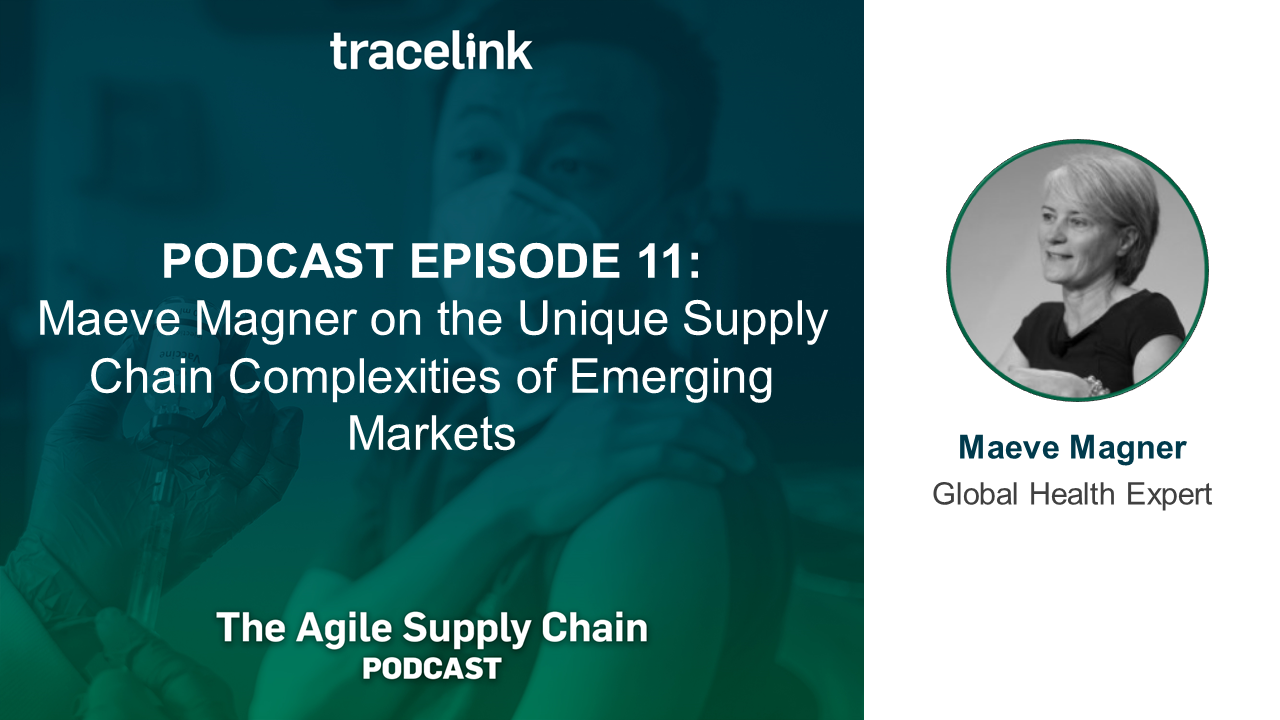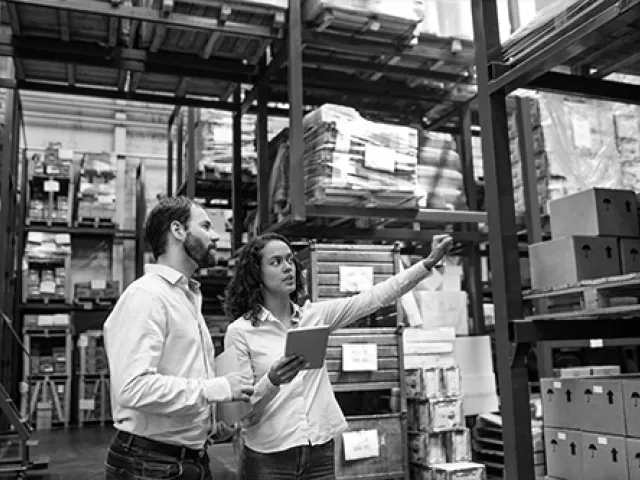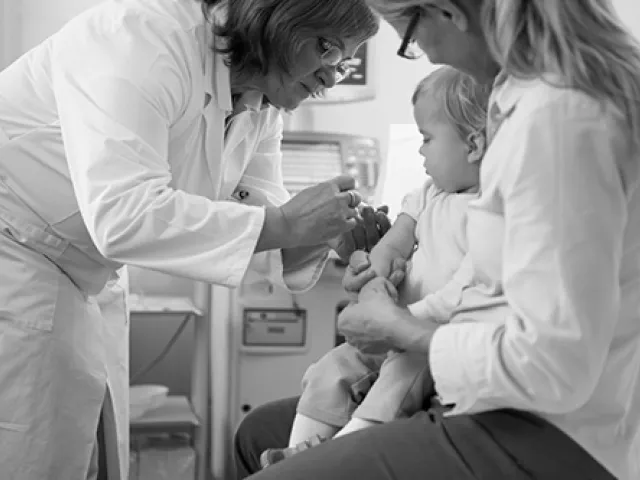Table of contents
Key Takeaways
- Despite a high burden of disease, limited supply, and a complex financial model, emerging markets are often early adopters of supply chain technology.
- Lessons learned from Ebola have provided a framework for COVID-19 response in African markets, including restricting travel and contact-tracing capabilities, but challenges persist.
- Emerging markets are making progress toward patient-centric models, but in many cases have different drivers than in industrialized markets.

Global health expert Maeve Magner joins TraceLink’s Roddy Martin to discuss how large-scale disruptions like COVID-19 can create complex challenges—and opportunities—for emerging markets across the world.
Transcripts:
Global health expert Maeve Magner joins TraceLink's Roddy Martin on "The Agile Supply Chain Podcast" to discuss how large-scale disruptions, like COVID‑19, can create complex challenges and opportunities for emerging markets across the world.
Roddy Martin: Welcome to an old friend. I have a lot of respect for Maeve. I've worked with her on the Bill & Melinda Foundation where she did a great job leading the original strategy for the Visibility Analytics Network.
Maeve comes from a consumer electronics background but really understands healthcare and is engaged today in emerging market strategy. Maeve, let me hand over to you and let you introduce yourself and your background in the industry.
Maeve Magner: Hi, Roddy. It's great to talk again and thank you for the opportunity to come on. For me, I've been working in supply chain for over, I think, 35 years now. A lot of it, as Roddy said, in the high‑tech industry, but more recently, the last 12 years or so in global development, so working on medical supply chains in low and middle‑income countries.
Currently, I'm supporting a global organization on the diagnostics for COVID. We're dealing with a lot of supply chain challenges. It's been very interesting actually to see how supply chain has come to the forefront of many people's minds over the last five or six months as we've been seeing this pandemic spread.
Again, thank you, Roddy, for the opportunity to talk to you today.
Roddy: Maeve, it's fantastic to talk to you because in this thought leadership series where we've spoken to Procter & Gamble, to Patheon, to leaders of consulting organizations. They've all tended to take a developed market perspective. As we were talking just before we started, there's some real fundamental differences.
As I was saying, Paul McKenzie, the COO of CSL Behring said, "In the pandemic, CSL in particular, has had to flex every one of its muscles," He said, "to learn and continuously adapt in sites around the world. Technology is a big piece of the equation."
What's different in emerging markets? What makes it so different?
Maeve: First of all, I'll clarify. When we talk about emerging markets, I think many people will look to India and China as emerging markets even though we know that they're beyond that. Emerging markets for me is low‑income and low‑middle‑income countries.
We would be looking at South Africa, Nigeria, Kenya. We will be looking at the Pacific Islands, also in Latin America, many of the countries there and in The Caribbean, just for context. However, we do still do a lot of work with India and with China.
What's different in the low and the low‑middle‑income countries, especially from a healthcare standpoint, the burden of disease is actually quite significant, and the resources available for the medical supply chains is not as much as needed given the burden.
Additionally, a lot of the financial support comes from global donors. That would be the likes of USAID, UK Aid, Bill & Melinda Gates Foundation, and others. It becomes a very, very complex situation in terms of decision making, in terms of financing, in terms of resources available.
In addition to that, the capacity within many of these countries for the usual supply chain actors, whether that is transportation, warehousing, whether that's the capacity around strategic procurement/forecasting is not as mature as what you would see in developed countries. Also as well, we're seeing many regulations are constantly changing.
There's multiple differences in terms of the maturity of these markets and the complexity of the stakeholders. We're also seeing as well that given the burdens of disease that we're seeing and the lack of resources we also see the adoption of technology and innovation is actually quite good and happens quite quickly.
We do get to see the adoption of technology in the most unlikely places. For instance, we see drones delivering blood in remote and rural Rwanda, as well as kicking off a national blood distribution system in Ghana as well. We also see the adoption of smart temperature monitors in Senegal and in Uganda. There are pros and cons in comparison to the developed markets.
Roddy: Maeve, you made a really interesting point about what are supply chain disruptions. I think in the pandemic scenario, we've seen a lot of the developed markets. The first world markets have had to flex all their muscles.
You made the point that just remember that in countries like Africa, there aren't necessarily good infrastructures. A bad storm or a bad wind can take out infrastructure, which has a massive impact on the supply chain. That's not necessarily what we're having to deal with in developed markets.
What makes that different in terms of the way they lead it? How important the role that technology plays to get visibility and communicate? What comments could you make in respect to that difference?
Maeve: There's a couple of different comments there. One, you're correct. In many of these markets, reliable access to resources like water, electricity, and so on and so forth is not a given.
Then in addition to that one, we do have storms coming and knocking out some of that infrastructure in that it makes it quite challenging for countries. However, I do believe in many of the developing countries, they're used to these disruptions on a regular basis and have to adapt to that quite quickly.
When I look at some of the challenges that we've seen recently in terms of natural disasters, take Mozambique, for instance, the last year, they had two significant cyclones that have come through. They had a massive impact, not just in Mozambique but right across several countries, including Zambia, Malawi, and some of South Africa as well.
When we look at what the response would be like in the US for the storms that they've had, there's a lot more financial resource, and then there is an awful lot more national and state‑level support that happens. Similar in the Irish context, which is my background.
However, in many of these countries, they don't have those additional resources to add both financial and expertise to address these. They have to be creative. They also have to think about how they can leverage different, I would say, donations or different offers of help from both overseas governments as well as from technology partners and private sector in that.
We have seen a lot of more meaningful support and donations that are happening, rather than just writing a check or donating a couple of trucks. What we're seeing in the Mozambique situation last year was that there were massive outbreaks of cholera. It was really essential for them to get on top of that because their health system was weak as it was.
They partnered with an organization called Zenesis. Zenesis helped them to pull together different information sets that were sitting within different organizations, sitting within different systems, and were able to provide a clear picture, a coherent picture around the cholera outbreak and where the infections were happening.
They were able to do some modeling and look at how best to address the outbreak. In doing so, we're able to go from a situation where there was 400 new cases of cholera happening every day, and they started happening and they were doubling every day to within three weeks. They were down to zero new infections.
What we're seeing is that these engagements with these governments and low middle‑income countries is actually becoming a lot more sophisticated. They're looking to see how they can leverage the offers of helper, the partnerships that are there to address the biggest issues first.
Roddy: Maeve, you lead into a great topic. For the last five years, there's been this wave of euphoria around control towers and visibility. If I have visibility in my supply chain, I've solved all my problems. What a lot of companies realizing, and countries is that visibility without context is not necessarily actionable.
In my work with you on the Bill & Melinda Gates Foundation, I called you out in a profound BMGF team that said, "Look, we're not calling this a control tower," not many people. I think they know this intuitively, but they don't realize that Africa is not the United States North America.
It's more than 50 countries. Some of those countries are at war with each other. They don't talk to each other. They don't share information with each other. When you come up with a concept like a control tower, the media response is, "Well, where are you putting this one control tower for Africa because not everybody is going to accept that?"
The Bill & Melinda Gates Foundation team and you came up with an idea that it's actually a Visibility and Analytics Network (VAN), which I think is profound in many ways. I think that brings about a difference in the way these issues are led.
In developed markets today with the pandemic, it's questionable about how good the leadership is. In Africa, just as an example of a low‑income market, governments play a much bigger role in how drugs are distributed.
There's been the recent case in Zimbabwe where one of the ministers has been put in jail because of diverting PPE products and reselling PPE products, not letting them go. How is Africa dealing with it? Is it just dealing with it through strong autocratic leadership? Are they being governed by the big NGOs? How is that playing out?
Maeve: Specific to COVID, I think Africa did a phenomenal job. When I say Africa, I mean the majority of the countries in Africa did a phenomenal job in responding early. I think a lot of that is because of the Ebola crisis and having to deal with that several years ago.
What you saw happening was that a lot of the borders were shut down, especially flights coming in from the UK, from other European countries, and obviously from China as well too. We started to see a lot of the major shutdowns happening when it had spread to Europe.
I think that the governments there were able to take the lessons learned from the Ebola crisis and the spread of the Ebola and do that.
First of all, it was about locking down the borders and really more about incoming flights. The second piece of it was around contact tracing. Again, because of Ebola but also because of the major vaccination programs that they have such as polio and that. They were able to tap into those systems, and so they were able to respond quicker.
However, a big part of the response needs to be around the testing. Many people talk about the vaccine, but quite frankly the vaccine, we don't know if and when that's going to arrive despite all of the money that's been spent on it.
To me, what's a lot more important is access to the diagnostics, to the testing. Between contact tracing and testing, that is important to be able to manage and address the spread of COVID. One of the disadvantages of these low and middle‑income countries is that they can't compete with the US going out and buying up all of the therapeutics or the tests or the UK doing the same thing.
We've seen a lot of that where the big governments, the developed country governments are going out and trying to corner the market the supply for the test products and are even quite frankly right now, starting to do the same around a vaccine even though it's not available.
There has been, through some of the UN systems, structures put in place to ensure that the low‑middle‑income countries will get access to these tests, which is critically important, because as long as it is anywhere across the globe, we're all at risk.
I do think I give credit to the African countries and the African leaders. I do think that part of the African Union, which seems to be getting a lot stronger over the last couple of years.
When I say a lot stronger, a lot of the leaders are coming together and thinking about how Africa as a continent can do better into trade, can do better in terms of managing or addressing some of these pandemics and some of these conflicts themselves.
We are seeing a rise in that. I want to go back on something as well too because when we talk about supply chain, a lot of people talk about products. What we have, I'm seeing, that is extremely important in low and middle‑income countries is when you talk about supply chain, you talk about it in terms of product movement.
You talk about it in terms of information movement, and you also talk about in terms of the financial flows. Many times we'll see that we have challenges around the supply chains, not because we don't know how much we need or where it needs to be or when it needs to be there, but the money is not available to pay for the products, either to buy them in the first place or to transport them or store them.
Other times we see where we have the money and we have the products, but we don't know what's needed where and when, so it is important to be getting back that information around consumption, but also as well to understand they need the scaling up of the campaigns.
When we look at our current COVID situation, this is extremely important. Again, from a testing standpoint, it's a big challenge because we have our current PCR test which will help you to know whether or not you have COVID.
We also are moving toward the antibody testing, which will help us to understand whether or not we've had COVID or who has had COVID, but also help us get a better idea on the immunity as well.
It's extremely challenging to understand what the needs are as the testing strategies are changing constantly, and then ensuring with the limited supply, that it is getting to where we need it to be and to ensure that all governments are playing fair and not stockpiling and leaving others in jeopardy.
That's another difference, I would say, in terms of how we think about supply chains when addressing low and middle‑income countries.
Roddy: That's a fantastic perspective. I used the expression in one of my blogs that testing is the new Manhattan Project, the global Manhattan Project because, quite honestly, exactly to the point you make.
We don't even know if we're going to get vaccines that work. We don't know if vaccines are going to be available, what scale they're going to be available. There's already talked about vials and containers for vaccines are in short supplies.
We've got some basic issues that we're dealing with. What I've found interesting, and I think it would be interesting to hear a perspective from you, and that is after AIDS and the discussion of AIDS in Africa is legendary.
After Ebola and now with coronavirus, is there awareness in their governance about testing perhaps much better than what we're seeing in the rest of the world? I'm almost seeing a flaunting of testing like, "Why do I need to be tested. It's my whatever right to be free and do what I want to do and etc."
Is there a different governance structure around testing? You made the point TraceLink's conference that the patient is you. We are the patients. We can't look to somebody else to look after us. If ever that's more true, it's in the low‑income markets where it does start with a patient.
They have to think patient‑backed because the patient may be in a clinic up in the mountains that takes half a day to get to in a vehicle. Whereas in the United States, we think about patient, we say it's all about privacy of patient data.
Is that patient‑centric thinking more embedded into the way that low‑income markets think because they have to think about and plan around the patient?
Maeve: That's a great question. I guess my initial reaction is that it hasn't been as much patient‑centric as it should be. However, in the last few years, we are starting to see that change a lot. Recently we're seeing that change is because sometimes we are missing people.
If we look at it here and it's around HIV, it's important you have a strong adherence in taking those medicines and it's something you have to take every day for the rest of your life.
We also see as well that it's important around malaria that you're taking the necessary precautions as well, especially with stuff like bed nets and the use of bed nets and so on so forth.
We also see that in other areas, in reproductive health as well too, that ensuring the availability of a variety of different contraceptives is important, but then it is up to the woman herself to make that decision on which type of contraception she wants to use versus what a government or a daughter agency may feel that she should.
In the last few years, what we're starting to see is that we're solving for the problem of the supply of medicines.
Now what we need to be solving for, is ensuring that the choice is there and that the patient is being brought into the center of this so that we're making sure that the products are available when and where the patients are, and that we're not losing patients or we're not losing citizens because the products are not available where they're going to go.
An example of that would be with malaria medicines, a lot of those had been available in public health centers. When you go to the public health center, if they were stocked out or if it was busy and you had to wait in line for four hours or five hours or a day in some instances, then you wouldn't go. That's a disincentive to go.
Then you would go to your local, informal pharmacist who might give you a counterfeit medicine than give you pro‑quality medicine. Now, we have to make sure that we understand the patient decisions or the citizen decisions.
The beneficiary decisions about where to go to access medicines or to access tests or to access contraception. We make sure that they're available. We have to take into consideration their behaviors. We have to take into consideration their decision processes.
We have to make sure that we're building the supply chains around that versus building the supply chain for products only. It's taking a while, but it's certainly is a lot more of a focus. I would say though, in this COVID situation, that I don't feel we have the same focus on that.
I think a lot of that is because demand has been outstripping supply, especially on the diagnostic side of it. As you know, we don't have any specific medicine that has been proven yet to help.
I know there's several out there, but the focus has been on trying to get manufacturers to scale‑up their capacity and make sure there's enough, whether it is PPE, whether it is diagnostics, whether it is ventilators.
All of consumers will go at that, to make sure that they are sufficient to meet all of the needs around the globe, not just one or two. The second part of that is that it's also important to ensure the quality of that product.
There's many, many organizations that are jumping on the bandwagon, and that are producing PPE and tests and different types of medicines, but they're not of good quality. At the end of the day, it's a waste of government resources, including our own large government.
Also, it doesn't help in addressing the COVID response. There's a big focus on quality as well, and the organization that I'm currently consulting with is doing some independent evaluation around the tests so that when people are going to buy the tests, or when governments are going to buy the tests, that they have some reference points in terms of the quality of these products as well.
Roddy: If you're in the position to when you finish that study, and it's publicly available information, I'd love to do a separate webinar on that with you. I think the subject of testing is quite honestly, that's the part of the iceberg that's under the water.
I don't think we've realized the significance and the complexity of global testing. I remember right at the beginning of the COVID scenario, one of the big pharmaceutical companies was literally doing rudimentary tests on people walking in and out of their buildings on their site.
Somebody going from one part of the campus to another part of the campus and going into a lab infected could shut the whole facility down. They had realized in December, January already that testing was an absolute core capability of this whole program.
Maeve, thank you very much. As an ex‑South African, and as somebody who ran a 3PL logistics company in Southern Africa, this is a fascinating story. I'm not sure that everybody understands and has a good grasp of the fundamental differences.
I think that's what you drew out, where we take certain things for granted and we deal with natural disasters. Yes, we have a flood, we deal with it and we move, but in Africa, it wipes out infrastructure that sometimes takes five years to rebuild.
That wipes out some of the absolute most basic necessities like electricity and water, etc. It's fantastic to hear from you. I love talking to you because I learn something, and I get insights of something different every single time we interview you.
Thank you for making the time. As I said, when you've done some studies on testing, I'm sure they're repeatable or they are learnable for other countries and other supply chain executives to see. We'd love to hear your opinion.
Thank you for making the time, and it's always a pleasure to have you on these webinars and panels. Thank you, Maeve.
Maeve: Thank you, Roddy. Thank you for hosting these. They're also very informative for me, so I greatly appreciate it as I'm sure many of us do as well.
Return to: The Patient-Driven Supply Network






